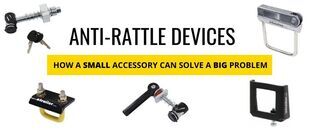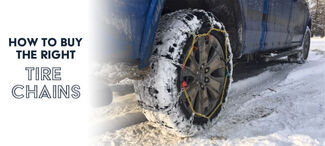
Engine Oil Coolers
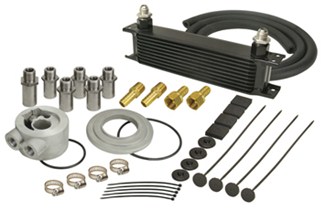
Why do I need an engine oil cooler?
Your engine functions at its best when the oil is between 180 and 200 degrees. Most factory cooling systems, however, maintain fluid temperatures of approximately 200 to 220 degrees, which means the maximum temperature drop it can create in your oil still exceeds the ideal temperature. Installation of an engine oil cooler can solve this problem by working with your factory cooler to provide the necessary additional cooling power.
Types of Coolers
The heat exchanger is the cooler itself, the core that works to maintain proper fluid temperatures. There are three basic types of heat exchangers.
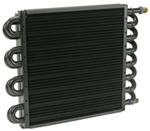
Tube and Fin
- Fluid flows through tubes and transfers heat out to fins
- Copper tubing offers superior conduction
- Aluminum fins allow for maximum heat dissipation
- Fins transfer that heat out into the surrounding air - greater airflow results in faster transfer
- Tube and Fin Coolers are moderately efficient and often larger in size

Plate and Fin
- Fluid spreads out along finned chambers to cool faster
- Turbulators agitate fluid continuously to facilitate heat transfer and prevent pressure drop
- Plate and Fin Coolers are very efficient and relatively smaller in size

Stacked Plate
- Fluid spreads out over maximum surface area for superior cooling
- Plate core can cool a greater volume of fluid faster than other heat exchangers
- Stacked Plate Coolers are the most efficient and typically smallest in size
Installation
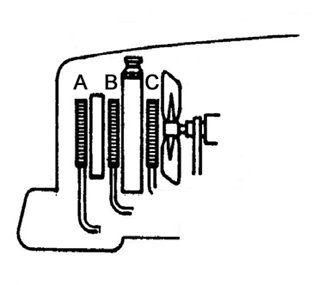
Cooler Kits
The cooler kits are designed to be mounted flush against either the radiator or the AC condenser core. For maximum cooling ability, the heat exchanger must receive the most airflow possible.
Position A
Mount cooler between your vehicle's grille and the AC condenser core for the greatest efficiency.
Position B
Mounting the cooler between the condenser and the radiator still allows for ample airflow, but cuts effectiveness by 25 percent. Installation of a larger cooler unit in this position may help make up for that loss.
Position C
Mounting the cooler between your engine and radiator considerably decreases the available airflow and causes the cooler to be 40 percent less efficient than if mounted in Position A. It is recommended that you purchase a larger cooler to make up for that loss if using in Position C.
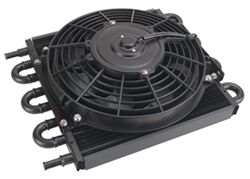
Remote-Mount Units
- Ultimate efficiency with high-powered fan mounted to cooler - superior airflow no matter where you mount it
- Choice of heat-exchanger core
- Tube and fin
- Plate and fin
- Stacked plate
- Remote-Mount Units are great for environments where steady airflow is limited - heavy traffic, off-roading
Oil Line Adapters
For engine oil coolers, installation can be a bit more complex. To access the oil lines, you will need either a spin-on or a sandwich adapter.
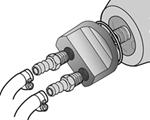
Spin-On Adapter
- Spin-On Adapters mount on oil filter landing and supply external lines for cooler
- Requires you to move your oil filter from its factory position and remote mount it elsewhere in the engine compartment
- Remote mount your filter in an easily accesible location for easier oil changes
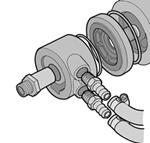
Sandwich Adapter
- Sandwich Adapters mount between engine and oil filter and supply external lines for cooler
- Allows oil filter to remain in factory-installed position
- Includes thermostatic bypass system (on most models) for quicker engine warm-up and system-pressure maintenance
Please Note:
Both adapters connect directly to the factory oil filter landing, so you will need to determine the exact thread size of your filter before making your purchase to ensure proper fit. If you do not know the thread size, universal kits are available to fit any application.
Updated by: Raymond P.
Last updated: 6/26/18
Keeping Other Systems Cool
Should I be worried about keeping other systems cool too?
Absolutely. Most of Derale's coolers can be used not only for engines, but for transmissions, power steering and fuel systems as well. A power steering cooler will extend the life of both the pump and seal, drastically reducing heat-related pump failures. Installation for power steering and fuel systems requires only the heat-exchanger core and basic accessories.
To learn more about transmission coolers, go here.
Departments
Towing
- Trailer Hitch
- Fifth Wheel
- Gooseneck
- Towing a Vehicle
- Front Hitch
- RV Hitch
- ATV Hitch
- HD Truck Hitch
- Vehicle Wiring
- Brake Controller
- Ball Mounts
- Weight Distribution
Sports and Recreation
Trailer Parts
- Utility Trailer
- Boat Trailer
- Landscape Trailer
- Enclosed Trailer
- 5th/Camper Trailer
- Car Hauler
- Horse Trailer
Vehicle
Contact & Help

What our customers are saying:
"I like the easy of navigation through the site. It only took me a couple of minutes to place my order. Thank You I will shop this sight again in the future."
Popular Vehicles
- Subaru Forester
- Ford F-350 Super Duty
- Ford F-250 Super Duty
- Chevrolet Silverado 1500
- Jeep Wrangler Unlimited
- Jeep Wrangler
- Ram 3500
- Toyota Highlander
- Ram 2500
- Chevrolet Silverado 2500
- Subaru Outback Wagon
- Chevrolet Silverado
- Dodge Ram Pickup
- GMC Sierra 2500
- Ram 1500
- Ford F-250 and F-350 Super Duty
- Jeep Grand Cherokee
- Toyota Tacoma
- GMC Sierra 3500
- Toyota Tundra
- Ford Escape
- More >>

















